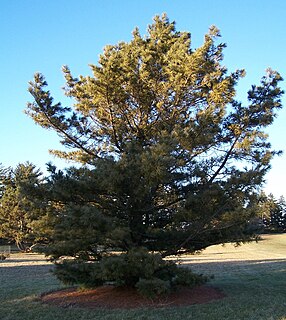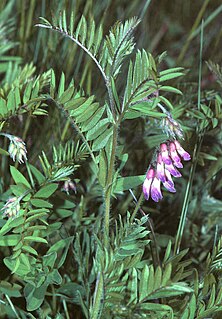
Jasmine is a genus of shrubs and vines in the olive family (Oleaceae). It contains around 200 species native to tropical and warm temperate regions of Eurasia, Africa, and Oceania. Jasmines are widely cultivated for the characteristic fragrance of their flowers. A number of unrelated plants contain the word "jasmine" in their common names.

Vicia sativa, known as the common vetch, garden vetch, tare or simply vetch, is a nitrogen-fixing leguminous plant in the family Fabaceae. Although considered a weed when found growing in a cultivated grainfield, this hardy plant is often grown as green manure or livestock fodder.

Allium tuberosum is a species of plant native to the Chinese province of Shanxi, and cultivated and naturalized elsewhere in Asia and around the world.

Pinus koraiensis is a species of pine known commonly as the Korean pine. It is native to eastern Asia: Korea, northeastern China, Mongolia, the temperate rainforests of the Russian Far East, and central Japan. In the north of its range, it grows at moderate elevations, typically 600 to 900 metres, whereas further south, it is a mountain tree, growing at 2,000 to 2,600 m elevation in Japan. Other common names include Chinese pinenut.

Vicia cracca, is a species of vetch native to Europe and Asia. It occurs on other continents as an introduced species, including North America, where it is a common weed. It often occurs in disturbed habitats, including old fields and roadside ditches.

Vicia is a genus of about 140 species of flowering plants that are part of the legume family (Fabaceae), and which are commonly known as vetches. Member species are native to Europe, North America, South America, Asia and Africa. Some other genera of their subfamily Faboideae also have names containing "vetch", for example the vetchlings (Lathyrus) or the milk-vetches (Astragalus). The broad bean is sometimes separated in a monotypic genus Faba; although not often used today, it is of historical importance in plant taxonomy as the namesake of the order Fabales, the Fabaceae and the Faboideae. The tribe Vicieae in which the vetches are placed is named after the genus' current name. Among the closest living relatives of vetches are the lentils (Lens) and the true peas (Pisum).

Physocarpus, commonly called ninebark, is a genus of flowering plants in the family Rosaceae, native to North America and northeastern Asia.

Ligustrum obtusifolium is a species of privet, native to Japan, Korea and northeastern China. The species is considered invasive in parts of the United States. It has become very common in southern New England, the mid-Atlantic States, and the Great Lakes regions, with scattered occurrences in the South, the Great Plains, and Washington state. With Ligustrum ovalifolium it is a parent of the widespread hybrid Ligustrum × ibolium.

Vicia hirsuta or Ervilia hirsuta is a species of flowering plant from the large genus Vicia.

Vicia tetrasperma the smooth tare, smooth vetch, lentil vetch or sparrow vetch, is a species of flowering plant from the large genus Vicia of the legume family Fabaceaae. It can be invasive.

Anaphalis margaritacea, commonly known as the western pearly everlasting or pearly everlasting, is an Asian and North American species of flowering perennial plant in the sunflower family.

Vicia lathyroides is a plant species in the bean family Fabaceae. It is native to Europe and western Asia, and it is known on other continents as an introduced species. It is an annual herb with pealike blue- or purple-tinged flowers about half a centimeter wide and hairless legume pods up to 3 centimeters long.

Diphasiastrum complanatum, common names groundcedar, creeping jenny, or northern running-pine, is a species of clubmoss native to dry coniferous forests in colder northerly parts of the world. Under the original name Lycopodium complanatum, this was an inclusive superspecies that included a number of other species now known to be biologically separate.

Malus prunifolia is a species of crabapple tree known by the common names plumleaf crab apple, plum-leaved apple, pear-leaf crabapple, Chinese apple and Chinese crabapple. It is native to China, and is grown elsewhere for use as an ornamental tree or as rootstock. It reaches from between 3 and 8 meters tall and bears white flowers and yellow or red fruit.
Hiroyoshi Ohashi is a botanist formerly at the University of Tokyo and Tohoku University. He began publishing on Japanese Arisaema in the early 1960s. He published a couple of miscellaneous notes on Arisaema in 1963 and 1964 and these were followed by a revision of the genus for Japan jointly published in 1980 with J. Murata, and by the Araceae treatment for the Wildflowers of Japan.

Vicia hassei is a species of vetch known by the common names Hasse's vetch and slender vetch.

Euonymus hamiltonianus, known by the common names Hamilton's spindletree and Himalayan spindle, is a species of flowering plant in the family Celastraceae. It is native to Asia, where it is distributed in Afghanistan, Russia, China, Japan, Korea, India, Nepal, Pakistan, Bhutan, Thailand, and Myanmar. This is one of the most common Euonymus species. It is cultivated in gardens and landscapes in other parts of the world.

Vicia minutiflora, commonly known as pygmyflower vetch or smallflower vetch, is a species of plant in the legume family. It is native to the Southeastern United States, where it is most often found in dry, open woodlands.

Mazus pumilus, commonly called Japanese mazus, is a species of flowering plant in the Mazaceae family. It is native to south and east Asia, where it is found in Bhutan, China, India, Indonesia, Japan, Korea, Nepal, New Guinea, the Philippines, Russia, Taiwan, Thailand, and Vietnam. It is an invasive species in North America.

Ixeris stolonifera, commonly called creeping lettuce, is a species of flowering plant in the aster family (Asteraceae). It is native to east Asia, where it is found in China, Japan, and Korea. It is a common and widespread species in Japan.



















